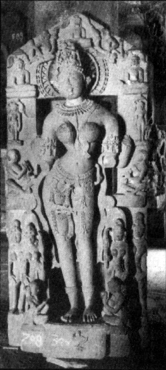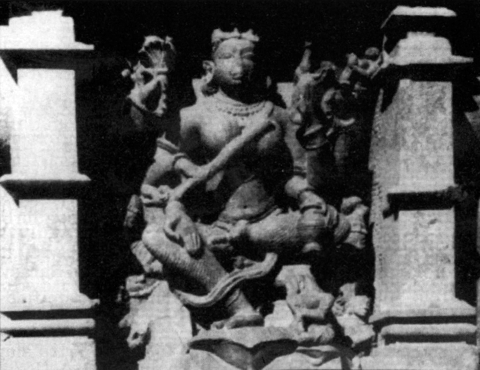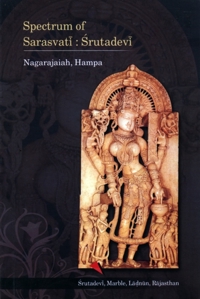 |
[17] Devagaḍh |
But the concept of 16 Vidyādevis or Mahāvidyās with their iconographic features is exclusively a Jaina innovation. They are mentioned in the Tijjayapahutta of Mānadevasūri (9th century), the Srutāvatāra of Indranandi (939), and the Stuti-Caturvimśatikā of Sobhana (937). Entrenched in Jaina psyche, Śrutadevī is Jinavāṇi. But, Śrutadevatā and the group of Mahāvidyādevīs are altogether different. The latter were conceptualized in circa 500 CE, not as goddesses of knowledge and arts like Sarasvatī (Śrutadevī), but as deities of magical powers.
However, Sarasvatī is not associated with any one Jina, where as Śāsanadevatas (yakṣa-yakṣis), are associated with particular Jinas. In other words and in the Jaina context Sarasvatī is Śrutadevī or Jinavāṇi, 'speech of Jina', and thus significantly differs from non-Jaina conception of this goddess. She invariably carries the book in her left hand, "The iconographic constant among Sarasvatī images is the book, which she carries to proclaim her role as the goddess of learning "[Pal 172 J. Sarasvatī has many aliases like Bhāratī, Brāhmi, Śārada, Śrutadevatā, Śrutadevī, Vāgīśvari, Vāgvādini, Vāk, Vākdevata, Vāṇi etc.
One of the cohorts of Jaina friars is called the Sarasvatīgaccha which also has other variants of Pustakagaccha, Śāradāgaccha, Hottage (Pustaka) gaccha, Āgamika gaccha and Sarasvatī gaṇa. All these variants figure in the eleventh and twelfth century inscriptions. Digaṁbara writer Śubhacandra (ca. 12th cent.) has authored the Sārasvata-yantra-pūjā grantha, a liturgical text. As an unique instance, the Sārasvatayantra-pūjā by Śubhacandra describes her as a goddess with three eyes trinetra-ramyāṁ! The third eye is obviously divya-cakṣuḥu, celestial eye.
Brahmasūri, an author proficient in Prakrit, Sanskrit and Kannada languages, has composed Sarasvatī-śatāṣṭanāma, '108 names of Sarasvatī', hymn in Sanskrit. The liturgical Sarasvatī-stotra, and Prākrita-Śrutabhakti are extant to confirm the prominence of Śruta and Śrutadevatā. In the configuration of Śrutadevī, the general concept of traditional Hindu Sarasvatī is subsumed with certain constraints;
-
The instance of Brahma's incest with his daughter does not arise in Jaina mythology.
-
The custom of offering of a ewe, and milch cow as a sacrifice for getting the wish fulfilled has been recorded in the Brāhmaṇas. The Aśvamedha ritual terminates with the tip of the sacrificial horse being offered to Sarasvatī [Vājasaneyi samhitā 25: 1], The Jaina narrative forbids all such sacrifices.
-
In the Vedic and Mahābhārata description Sarasvatī is deified river. In the Jaina version she is deified as Jinavāṇi, Jina's speech.
-
The concept of Sarasvatī and Indra as Vṛtra slayer does not appear in the Jaina mythology.
-
Similarly, the concept of rivers are Indra's wives, and analogous with it Sarasvatī is Indra's consort (Yajur Veda) etc., does not figure in Jaina tradition.
-
The incantation for safe pregnancy, delivery, or prayer to place the embryo in woman's womb is not found in the Jaina liturgical literature.
-
The Vedas and Mahābhārata narrate that Sarasvatī is invoked and worshiped by those monks dwelling on her banks. The Jaina counterpart Śrutadevī is extensively and profusely worshiped and invoked by Jaina Ṛṣis, monks, nuns, littérateurs and householders.
-
In the Jaina mythology also, Sarasvatī alias Śrutadevī is conferrer of boons, speech, fame, inspired thought and poesy. She is the inspiring deity for men of letters.
 |
[18] Pārśvanātha Temple, Khajurāho, 950-70 CE |
Thus the configuration has come a long way and undergone a great transformation from Sarasvatī to Śrutadevī who gradually took central stage to envelope Jaina learning.
Most of the śāsanadevas and devīs are either two or four-armed and some of them are described with akṣamālā in one of their hands according to either Digaṁbara or Śvetambara or both:
Yakṣa | (of) Tīrthaṅkara | Digaṁbara | Śvetambara |
Gomukha | Ṛṣabha (1st Jina) | • | • |
Mahā yakṣa | Ajitanātha (2nd) | - | • |
Śyāma | Candraprabha (8th) | • | - |
Ajita | Puṣpadanta (9th) alias Svidinātha | - | • |
Brahma | Śītalanātha(10th) | - | • |
Īśvara | Śreyāṁsanātha (11th) | - | • |
Pātāla | Anantanātha (14th) | - | • |
Kinnara | Dharmanātha (15th) | • | • |
Garuḍa | Śāntinātha (16th) | - | • |
Khendra | Aranātha (18th) | • | - |
Bhrukuṭi | Naminatha (21st) | - | • |
Interestingly, according to the Śvetambara texts, two more yakṣas-Anāvṛta and Brahmaśānti, carry both akṣasūtra and kamaṇḍalu [Hampana: 1976: 208].
In the Jaina pantheon, Brahma is not a creator. Jaina concept of cosmology and creation of the Universe does not accept that God (Brahma) created and will protect (Visṇu) and can destroy (Maheśvara). According to Jainism no God created this world and no God can destroy it. This world was there before and will be there for ever. Tīrthaṅkaras are neither creators, nor protectors or destroyers. Jaina canons are not apauruṣeya, 'not created by man'. Contrarily, Jaina āgamas are created by men. Therefore, Brahma, in the Jaina context, is an Yakṣa and is Śāsanadeva of the tenth Tīrthaṅkara Śītalanātha and haṁsa, 'goose', is his mount according to both the Dig. and Sve. sect.
Albeit, some Jaina poets fall in line with pan Indian-concept of Brahma-Sarasvatī and treat them as husband (father) and wife (daughter). Kannada poet Nemicandra (1175) states - 'Śrutadevī and Brahma are Yakṣi and Yakṣa to the venerable Lakṣmī called the Tīrthaṅkara-hood' [Neminātha Purāṇa, 1-16]. He expresses his delight that Śrutadevī has blessed him [Supra, 1-21].
Similarly, some of the śāsanadevīs are also described as holding aksamaṇi in one of their hands:
Yakṣi | (of) Tīrthaṅkara | Digaṁbara | Śvetambara |
Śānta | Supārśvanātha (7th) | - (Kālī) | • |
Sutāra | Puṣpadanta (9th) | - (Mahākālī) | • |
Mānavī | Śītalanātha (10th) | • | - (Aśokā) |
Dhariṇī | Aranātha (18th) | - (Tarāvatī) | • |
Vairoṭyā | Mallinātha (19th) | - (Aparājitā) | • |
Cāmuṇḍā | Naminātha (21st) | - | • (Gandhārī) |
Padmāvatī | Pārśvanātha (23rd) | • | - |
Āśādhara, Vasunandi and Nemicandra state that four-armed Padmāvatī (devī) has akṣamālā, 'rosary', in one of her hands. Accordingly Padmāvatīdevī at Hombuja-Kṣetra holds rosary in one of her hands. But many of the extant images of Padmāvatī do not carry rosary.
Therefore we cannot jump to the conclusion that all the images holding rosary and/or water-vessel are of Sarasvatī/Śrutadevatā. Careful consideration of attributes is necessary.
 Prof. Dr. Nagarajaiah Hampana
Prof. Dr. Nagarajaiah Hampana
